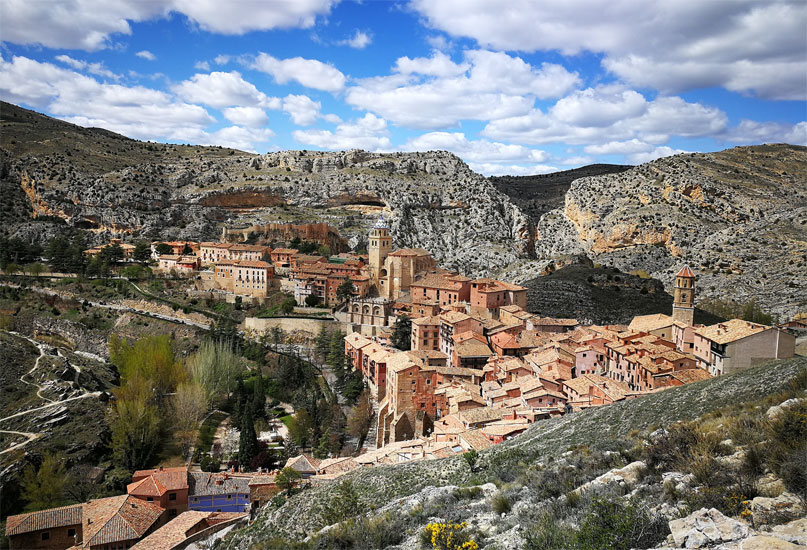Albarracin is a Spanish town in the southwest of the province of Teruel, in the autonomous community of Aragon.
One of the most picturesque towns of Spain with a well-preserved medieval fortress wall, Albarracin was named in honor of the Moorish rulers from the Al-Banu-Racin clan. From 1012 to 1104, it was the capital of the typhus (principality) of the same name, and after its collapse, it was the center of the lord of Albarracin, ruled by the Navarre clan Asagra.
The town has been a National Monument since 1961 It has the 1996 Gold Medal for Merit in Fine Arts, and it is proposed by Unesco to be declared a World Heritage Site for the beauty and importance of its historical heritage.
Today The city itself is a tourist attraction. The main attraction of Albarracin is the ancient fortress of Andador, which crowned the top of the hill with a notched crown. From its main tower, Torre del Andador, tourists admire the city. The walls of the castle have been preserved in the southwestern part.
Access : Coordinates: 40.408333, -1.439444 / The easiest way to get to Albarracin is from Valencia (located about 2 hours drive), or from Zaragoza (3 hours drive). / Valencia – Selya Train, bus number 047do Seli, 22 km by car or taxi by Train – 20.1 €.
By bus – 11.96 €.
Teruel – Selya By Bus (flights Monday to Saturday) line 047, from Seli by taxi By Bus – 31 € – 42 €
Barcelona – Selha by Train with a change in Zaragoza Delicias, from Seli by taxi by Train – 92 – 126 €.
Highlights :
- Andador Fortress/El Andador. – The city walls : Secured by square and semicircular towers, was built in the 14th century. Their enormous size suggests that new attacks were expected; it also enabled the admission of farmers and their cattle and an important expansion of the city, which was never done.
- The Alcazar is a free-standing part of the city fortifications and dates from the 10th century. Between 1088 and 1093, El Cid negotiated with the prince who resided here. In Christian times it was redesigned and provided with semicircular towers. Today there is a small ceramics museum .
- The Catedral de El Salvador, built between 1572 and 1600, was built on the site of a Romanesque predecessor further structural changes date from the baroque period. The lavishly arched apse contains a carved altar from 1566 with almost life-size figures.
- The Bishop’s Palace (palacio episcopal) dates from around the same time he also experienced numerous structural changes. Today the Diocesan Museum (Museo Diocesano) is here with numerous exhibits from different centuries.
- The City Museum (Museo de Albarracin) is located in the former hospital from the 18th century; it presents objects from the different epochs of the city’s history.
- The old town of Albarracin with its winding streets and houses made of stone, clay and half-timbered was already classified as Conjunto historico-artistico in 1961.
- Town Hall : The old town hall also appeared in the 16th century and is located in the same small Plaza Mayor. It has the shape of a horseshoe. The Guadalaviar River flows below, so the views in the surroundings are amazing.
- La Escalinata : A picturesque staircase of the city, located on its outskirts. But to go from the historical center for about 15 minutes. I advise everyone, very beautiful.
- other attractions: : Azure house / house of Navarro Arzuriaga / the cloister of Julianeta / tower Torre de Dona Blanca / chapel “Cristo de la Vega” / Torre de la Muela, now disappeared; similar to those of Andador and dona Blanca, it was on the other side of the river.
- Climbing : The main climbing areas in Albarracin are Techos, Arrastradero and Peninsula. They are like playgrounds for a bouldering player: the choice of routes for climbing here is not so simple, and the categories are very peculiar. These areas are a 15-20 minute walk from each other, and the nearest boulders are located just a few meters from the parking lot.
Activities : sightseeing / photo opportunities / trekking : / climbing / Guided tours
Go next : Prado Del Navazo : explore such underground labyrinths, examining every patch of land, admiring the rock paintings left from the Paleolithic. / The Montes Universales Nature Reserve spread out near the village.

